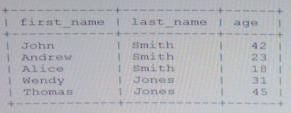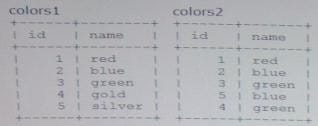Exam Details
Exam Code
:1Z0-882Exam Name
:MySQL 5.6 DeveloperCertification
:Oracle CertificationsVendor
:OracleTotal Questions
:100 Q&AsLast Updated
:Jul 03, 2025
Oracle Oracle Certifications 1Z0-882 Questions & Answers
-
Question 21:
Which statement describes the process of normalizing databases?
A. All text is trimmed to fit into the appropriate fields. Capitalization and spelling errors are corrected.
B. Redundant tables are combined into one larger table to simplify the schema design.
C. Numeric values are checked against upper and lower accepted bounds. All text is purged of illegal characters.
D. Columns that contain repeating data values are split into separate tables to reduce item duplication.
E. Indexes are created to improve query performance. The data of types of columns are adjusted to use the smallest allocation.
-
Question 22:
The people table contains the data as shown:

Which two statements return two rows each?
A. SELECT DISTINCT last_name, first_name FROM people
B. SELECT 1,2 FROM people GROUP BY last_name
C. SELECT first_name, last _name FROM people WHERE age LIKE `2'
D. SELECT 1, 2 FROM people WHERE last _name ='smith'
E. SELECT first _name, last_name FROM people LIMIT 1, 2
-
Question 23:
You started a MySQL command line session with sq1_ mode (empty), and created the person table with
the structure:
Mysql> DESC person;

You issue:
INSERT INTO person VALUES (`casper', `undefined')
What is the effect?
A. `Casper' and ` undefined values are inserted into the `name' and gender' column.
B. The server returns an error indicating that `undefined' cannot be inserted into a column of ENUM type
C. The server returns a warning and the empty string is inserted to the `gender' column.
D. The server returns a warning and the first specified value ,"male" is inserted to the gender column.
-
Question 24:
You create a new,empty database called `test'. You want to change the database `s CHARACTER SET to "latin1" and the database `sCOLLATION to `latin_german_ci'.
Which statement is true?
A. You can do this one command: ALTER DATABASE test CHARACTER SET latin1 COLLATE latin1_german_ci
B. You can only do this with two separate commands: ALTER DATABASE `test' CHARACTER SET latin1 ALTER DATABASE `test' COLLATE latin_german1_ci
C. You cannot change the CHARACTER set or COLLATION value on an existing database.
D. Databases do not have CHARACTER SET or COLLATION attributes.
-
Question 25:
You wish to create a trigger on the country table. It will populate two session variables based on the row that is deleted: @old _countryNames with the value of the Name field @old _countryName with the value of the code field
You may assume that only one row is ever deleted at a time. CREATE TRIGGER Country_ad AFTER DELETE ON Country FOR EACH ROW SET
@old _CountryName= NEW.Name,
@
old _CountryCode=NEW.Code;
What is the outcome of the CREATE TRIGGER statement?
A.
The trigger will be created successfully.
B.
An error results because the NEW keyword cannot be used in a DELETE trigger.
C.
An error results because FOR EACH ROW is invalid syntax.
D.
An error results because a BEGIN. . .END block is required.
-
Question 26:
Consider the content of the class and student tables: Class

Which three queries produce the same result?
A. SELECT * FROM class INNER JOIN student ON class.class_id=student.class_id
B. SELECT * FROM JOIN student LEFT JOIN student ON class. Class.class_id=student.class_id
C. SELECT * FROM class INNER JOIN student WHERE NOT ISNULL (student.class_id)
D. SELECT * FROM JOIN student On class .class_id=student.class_id WHERE NOT ISNULL (student.class_id)
E. SELECT * FROM student RIGHT JOIN class ON class.class_id=student.class_id
-
Question 27:
Which statement correctly demonstrates using a subquery as a scalar expression?
A. SELECT (
SELECT SUM (population)
FROM Country
SELECT SUM (population)
FROM Country
WHERE Code ='CAN'
)
B. SELECT SUM (population) FROM Country WHERE Code ="USA"
+ (SELECT SUM (population)
FROM Country
WHERE Code =.'CAN'
)
C. SELECT (SELECT SUM (population) FROM Country WHERE Code ='USA' FROM country WHERE Code= `CAN' )
D. (SELECT SUM (population) FROM Country WHERE Code ="USA'
-
Question 28:
Given the data:

Expected output: Which query produces the expected output?

A. SELECT colors2.name, colors1.name FROM colors2 OPTIONAL JOIN colors1 ON colors2.name, colors1.name
B. SELECT colors2.name, colors1.name FROM colors2 NATURAL JOIN colors1 ON colors2.name=colors1.name
C. SELECT colors2.name, colors1.name FROM colors2 STRAIGHT JOIN colors1 ON colors2.name, =colors1.name
D. SELECT colors2.name,colors1.name FROM colors2 LEFT JOIN colors1 ON colors2.name=colors1.name
E. SELECT colors2.name,colors1.name FROM colors2 RIGHT JOIN colors1 ON colors2.name=colors1.name
-
Question 29:
As a developer, you inherit this table as part of a project:
CREATE TABLE exam (
Exam_id INTEGER UNSIGNED NOT NULL PRIMARY KEY,
Examinee_id INTEGER UNSIGNED UNIQUE,
Score INTEGER UNSIGNED
)
What change should you make to ensure that examinee_id is an integer value throughout the table?
A. The examinee_id column should be designated as PRIMARY KEY.
B. A NOT NULL qualifier should be moved from exam-id to examinee-id.
C. The PRIMARY KEY should be dropped and re-created as PRIMARY KEY (examinee-id, exam_id).
D. A NOT NULL qualifier should be added to examinee_id.
-
Question 30:
You have access to a MySQL 5.6 database with the SELECT ,INSERT, and DELETE privileges on all
tables in the mydb database.
The mydb database.
The mydb t1 table has five rows of data.
You use the statement below to remove all rows in the t1 table:
Mysql> TRUNCATE TABLE mysql.t1;
What is the result?
A. The command succeeds and o rows are affected.
B. The command succeeds and five rows are affected.
C. The command fails owing to syntax error.
D. The command fails owing to permissions error.
Related Exams:
1Z0-020
Oracle8i: New Features for Administrators1Z0-023
Architecture and Administration1Z0-024
Performance Tuning1Z0-025
Backup and Recovery1Z0-026
Network Administration1Z0-034
Upgrade Oracle9i/10g OCA to Oracle Database OCP1Z0-036
Managing Oracle9i on Linux1Z0-041
Oracle Database 10g: DBA Assessment1Z0-052
Oracle Database 11g: Administration Workshop I1Z0-053
Oracle Database 11g: Administration II
Tips on How to Prepare for the Exams
Nowadays, the certification exams become more and more important and required by more and more enterprises when applying for a job. But how to prepare for the exam effectively? How to prepare for the exam in a short time with less efforts? How to get a ideal result and how to find the most reliable resources? Here on Vcedump.com, you will find all the answers. Vcedump.com provide not only Oracle exam questions, answers and explanations but also complete assistance on your exam preparation and certification application. If you are confused on your 1Z0-882 exam preparations and Oracle certification application, do not hesitate to visit our Vcedump.com to find your solutions here.